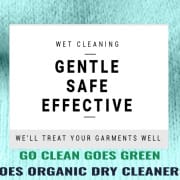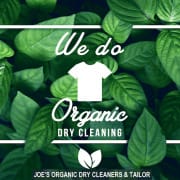ORGANIC DRY CLEANING is Soft to the Touch, has No Chemical Odors and No Residue, is Gentler than Hand Washing with a Fresh, Clean Scent Kind to Sensitive Skin Safe for your Clothing Better for Removing Stains Milder than Home Laundry Products Brighter, Vibrant Colors Without Fading Whiter Whites Gentle on the Environment.
WHAT DOES ORGANIC DRY CLEANING MEAN?
87% of people think it’s important for the ingredients in personal care products to be “Organic.” We are Launching a New Dry Cleaning System
Customers expect their high-quality clothes to be perfectly cleaned as inexpensively as possible and with minimum impact on the environment
It is a revolutionary and very efficient cleaning procedure for commercial textile care. Also, use Bio-based dry cleaning as part of the SYSTEMK4 process for human health and environmental protection. “Pure, Clean, Safe, Soft, and Damage free” It has also been Dermatologically tested with a “Very Good” result.
It’s you’re only as to keep healthy as what you put on your body. We believe the same goes for what you put on it.

IS ORGANIC DRY CLEANING BETTER?
It Means to Be eco-friendly means living in a way that is not harmful to the environment. This way of life is becoming increasingly important, as we need to protect our planet from man-made damage. There are various ways that an individual can make sustainable changes in order to lessen the negative effect that our daily lives usually contribute to. It is possible to be eco-friendly in different areas of our lives. Organic dry cleaners use environmentally friendly cleaning solvents. How can we protect our environment from pollution? However, this is just one of the benefits of using an organic dry cleaning company.
Joe’s Organic Dry Cleaners had a clear green mission, to protect the health of their people, their town, and the local environment. Core to that mission was replacing their cleaning system with a new state-of-the-art organic dry cleaning solution. They knew becoming an eco-friendly business was key to their future and the right thing to do.
GREEN BUSINESS MOVEMENT
Whether it’s to keep up with the competition or to abide by new legislation that is being introduced, today’s business environment is reinforcing eco-friendly business practices more and more. Some businesses are making green changes because they have to, but others are making them out of a belief in creating a positive impact for the communities they serve. Joe’s Organic Cleaners, a new Green Business Bureau Member, is setting out to do just that at their Westbury, New York dry cleaning business.
LEGISLATION CHANGES FOR DRY CLEANERS
By focusing on using an organic cleaning technique that is non-toxic and environmentally friendly, Joe’s Organic Cleaners is well prepared to meet the upcoming sustainability regulations in New York which will require dry cleaning businesses in residential buildings to discontinue the use of perc machines by December 21, 2020. They are ahead of the game with their investment in a dry cleaning machine that uses a non-toxic, K4 system. The bio-based K4 system not only cleans clothes in an environmentally friendly way, but it is also highly effective at cleaning garments. This has allowed the company to continue to provide a high level of quality service while successfully using a safer cleaning solvent.
FINDING WAYS TO INCREASE SUSTAINABILITY
In addition to investing in the K4 cleaning system, Joe’s Organic Cleaners is also focusing on other sustainability programs. These include:
Using dry cleaning distillation chill water and re-use for laundry;
Installing LED light bulbs for both in and outdoor use;
Undertaking an Apollo steam trap audit and installation program; and
Providing a hanger and plastic recycling program to customers.
These changes have reinforced the company’s commitment to sustainability, while also providing customers with ways to get involved in their green focus areas.
EVERYONE WINS WITH AN ORGANIC DRY-CLEANING BUSINESS
“We are trying to protect the health of the people in our building and community, and it’s important our residents and customers know we upgraded our dry cleaning machines to do that,” said Alex Kim, owner of Joe’s Organic Cleaners. “We may be a small business dry cleaning company, but we care about overall human health and ensuring effective environmental protection for a sustainable future. Complying with environmental regulations well before they go into effect is a bonus.”
Through a combination of investment in the latest technology, using the best available solvents and chemicals, and employing skilled employees, Joe’s Organic Cleaners is truly taking a green stand in the dry cleaning industry. Their GBB membership is yet another step that demonstrates their commitment to sustainability and being a truly green business.
















































